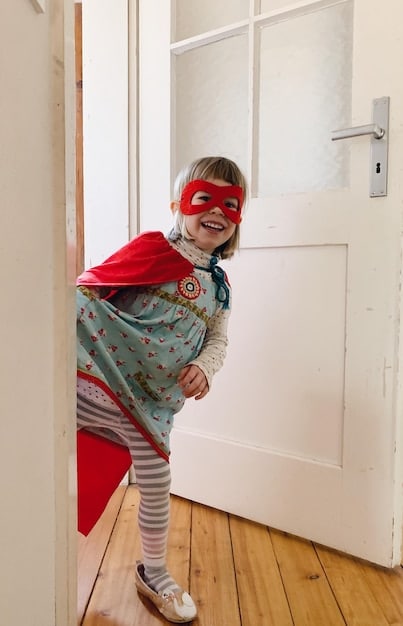Is Your Child Ready for Independent Play? 5 Key Milestones

Determining if your child is ready for independent play involves observing their emotional maturity, problem-solving skills, ability to follow simple rules, engagement in imaginative play, and comfort in playing alone, all of which typically begin to emerge around age 4.
Is your little one showing signs of wanting to explore the world on their own? Figuring out if your **child is ready for independent play? 5 Key milestones to watch for by age 4** can be a game-changer for both of you, offering them a chance to grow and you a bit of well-deserved “me” time.
Understanding Independent Play: What Does It Really Mean?
Independent play is more than just leaving your child alone with toys. It’s about fostering their ability to engage in self-directed activities, explore their creativity, and develop problem-solving skills without constant adult intervention. But what does this look like in practice?
Put simply, independent play is when a child can entertain themselves without needing constant attention or direction from a caregiver. This could involve anything from building a tower of blocks to pretending to be a superhero in their own imaginary world.
The Benefits of Solo Play for Children
Why is independent play so important? It offers many benefits for a child’s development, including enhancing creativity, problem-solving skills, and self-confidence. It’s a time when children can truly explore their own interests and inner world without the influence or direction of others.
- Boosts Creativity: When left to their own devices, children come up with new and inventive ways to play with toys or even create games out of thin air.
- Enhances Problem-Solving Skills: Challenges arise during play, like a tower that keeps falling over. Children learn to strategize and overcome these obstacles independently.
- Increases Self-Confidence: Successfully navigating playtime solo gives children a sense of accomplishment and bolsters their self-esteem.
- Develops Emotional Regulation: Playing alone allows children to process their emotions and learn how to self-soothe without relying on external validation.
In essence, independent play sets the stage for a child to become a confident, imaginative, and resourceful individual. It’s a crucial part of their development journey.
Milestone 1: Emotional Maturity and Independence
One of the primary signs that a child is ready for independent play is their level of emotional maturity. This isn’t about them being perfect little angels all the time, but rather showing an ability to manage their emotions and handle simple frustrations on their own.
At around age 4, children begin to develop a greater capacity to understand and express their feelings. They also start to learn how to cope with minor setbacks without immediately needing adult intervention.
Signs of Emotional Readiness
What specific behaviors indicate that a child is emotionally ready for solo playtime? Look for things like the ability to express feelings verbally, the capacity to self-soothe when upset, and a general sense of security and confidence.
- Expressing Feelings Verbally: Can your child articulate how they feel, using words like “sad,” “angry,” or “frustrated?”
- Self-Soothing: Do they have strategies for calming themselves down, like hugging a favorite toy or taking deep breaths?
- Comfortable Being Alone: Are they generally content in their own company, without constantly seeking attention or reassurance?
These signs of emotional resilience are key indicators that your child is ready to explore the world of independent play with confidence.

Milestone 2: Problem-Solving Skills Development
Another critical milestone in determining a child’s readiness for solo play is the development of their problem-solving skills. This doesn’t mean they have to be master strategists, but they should demonstrate an ability to tackle simple challenges on their own.
Around age four, kids start to show more logical thinking and can usually follow basic instructions. This is important because when they play by themselves, they often encounter problems they’ll need to solve independently.
How to Spot Problem-Solving Capabilities
There are simple ways to observe your child’s problem-solving skills. Watch them as they play with toys or attempt to complete tasks. Can they figure out how to build a tower, put together a simple puzzle, or operate a toy on their own? These are all good signs.
If they encounter a problem, do they try to figure it out independently before asking for help? Do they show persistence, or do they give up easily?
Giving your child opportunities to solve problems independently, even small ones, will build their confidence and enhance their ability to enjoy solo play.
Milestone 3: Ability to Follow Simple Rules
The ability to follow simple rules is an important indicator that your child is ready for independent play, especially when it comes to safety. It ensures they understand boundaries and can play responsibly without direct supervision.
At this age, children can usually grasp the concept of rules and understand why they are important. This includes knowing what toys are safe to play with alone and where they are allowed to play without supervision.
Assessing Rule-Following Skills
How can you tell if your child is capable of following rules during independent play? Observe them to see if they adhere to instructions, even when you’re not watching. Do they follow directions in games, and do they respect boundaries you’ve set? For instance, playing indoors only, or no access to small objects which could be swallowed.
If they consistently break rules or disregard your instructions, they may not be quite ready for extended periods of unsupervised play. However, if they generally respect boundaries and follow directions, they are likely ready to enjoy solo playtime safely.
Reinforcing the importance of rules and boundaries will help them stay safe and responsible during independent play.
Milestone 4: Engagement in Creative and Imaginative Play
Another essential milestone is the ability to engage in creative and imaginative play. This is where children can really shine on their own, creating stories, scenarios, and worlds without the need for external input.
Around age 4, children’s imaginations are in full swing. They can transform ordinary objects into extraordinary things and create elaborate narratives with their toys.
Encouraging Imagination
To foster imaginative play, provide your child with a variety of open-ended toys like dress-up clothes, building blocks, and art supplies. Encourage them to come up with their own stories and scenarios, rather than dictating how they should play.
- Offer Open-Ended Toys:Provide toys that are adaptable for different types of play, such as plain wooden blocks, costumes, and art supplies.
- Encourage Storytelling:Prompt your child to narrate their plays and create backstories for their characters.
- Provide A Special Space:Designate a play area that encourages creativity and imaginative scenarios.
Imaginative play fuels their creativity, problem-solving abilities, and emotional growth, setting the stage for a lifetime of learning and self-discovery.

Milestone 5: Comfort and Contentment in Playing Alone
One of the most telling signs is their comfort level when playing by themselves. Some children thrive on social interaction and constant companionship, while others are perfectly content in their own company.
Around age 4, children typically begin to develop a greater sense of independence and self-sufficiency. They may start to enjoy spending time alone, exploring their own interests and engaging in solo activities.
Observing Comfort Levels
Pay attention to how your child reacts when given the opportunity to play alone. Do they resist the idea or seem anxious about being left to their own devices? Or do they embrace the chance to explore their world solo?
If your child seems comfortable and content when playing alone, it’s a good sign that they’re ready for more extended periods of independent play. If they still struggle with separation anxiety or constantly seek your attention, they may need more time to develop this skill.
Supporting their comfort level and encouraging them to embrace solo play can set the stage for a lifetime of independence and self-reliance.
| Key Milestone | Brief Description |
|---|---|
| 😊 Emotional Maturity | Ability to manage emotions and handle frustrations independently. |
| 🧩 Problem-Solving Skills | Capacity to tackle simple challenges and find solutions on their own. |
| ✅ Rule-Following | Understanding and adhering to simple rules and boundaries. |
| ⭐ Imaginative Play | Ability to engage in creative play and invent stories. |
Frequently Asked Questions (FAQs)
▼
Around age 4, many children begin showing signs of readiness for independent play, such as increased emotional maturity and an ability to follow simple rules.
▼
Provide a safe and stimulating play environment, offer open-ended toys, and gradually increase the amount of time they spend playing alone.
▼
Start with short periods of solo play and gradually increase the duration. Offer encouragement and praise when they engage in independent activities.
▼
Yes, it’s normal for children to have varying levels of comfort with solo play. Be patient and supportive, and allow them to develop this skill at their own pace.
▼
Independent play enhances creativity, problem-solving skills, self-confidence, and emotional regulation, contributing to a child’s overall development.
Conclusion
Determining if your child is ready for independent play requires a careful consideration of several key milestones. By observing their emotional maturity, problem-solving skills, rule-following abilities, engagement in imaginative play, and comfort in playing alone, you can make an informed decision that supports their development and well-being.





